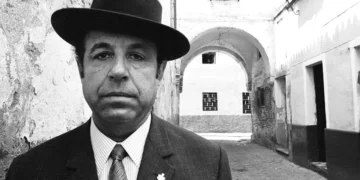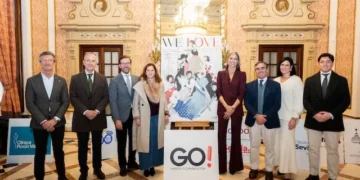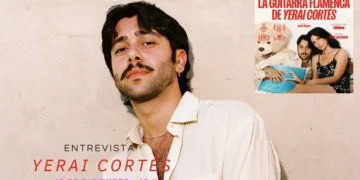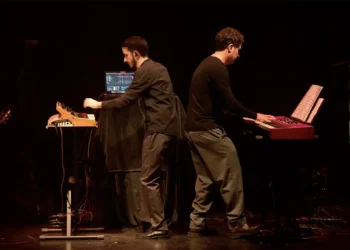|
Valle
| Daily coverage BIENAL DE FLAMENCO sponsored by: |
Pepa Montes (dance), Ricardo Miño (guitar), Vicente
Gelo (cante), José Jiménez ‘Bobote’ (palmas
and dance), Rafael Serrano ‘el Eléctrico’ (palmas
and dance), Antonio Barrull (percussion), guest artists: Manuel
Molina, Fernando Terremoto, Segundo Falcón, and the special
collaboration of Pedro Ricardo Miño (piano), Jesús
Vigorra (off-stage voice).
It’s the home stretch of the Bienal and this was
something that was sorely needed. Despite some valiant efforts,
few and far between have been the moments when we have felt overcome
with the magic of it all. The shows and premieres worked out to
perfection in some cases, or the absence of perfection in others,
complicated by the low overall interpretive quality and opportunistic
staging with an eye to cutting corners at the world’s greatest
flamenco showcase, just don’t add up to much. However “Bailaora”
was somehow different, visceral, intimate, flamenco, magical….and
long.
Family ties were partly to blame. Ricardo Miño on the guitar;
his wife, dancer Pepa Montes, the star of the night; Pedro Ricardo
Miño, their son, on the piano. The rest, just like family:
“El Eléctrico” and Bobote doing palmas, with
the bulería “El Morapio”, bulerías that
sounded from another era when feeling mattered more than virtuosity;
Vicente Gelo singing, Antonio Barrull handling the percussion, and
guest artists like Fernando Terremoto, Segundo Falcón and
Manuel Molina. Jesús Vigorra lent his voice to introduce
the second part of the show where he read the “Code of the
Seville School of Dance” by Matilde Coral to whom Ricardo
and Pepa dedicated their performance “with the greatest respect
and affection”. Nor was Rafael el Negro, husband of the illustrious
dancer from Seville left out.
Falcón starts out a capella and Pepa’s hair stands
on end with the depth of his lament. She gets up from her chair
and you can smell the drama when she fills every nook and cranny
with her movements and poses, and no music other than the beating
of the audience’s hearts. No concessions, the hand slowly
moves, the torso twists, the gestures are profound. Her heels beg
the guitar to begin and it obeys. Pepa Montes caresses elegantly
and leaves the showy flourishes for others. She measures each step
with grace, giving everything at every moment. No unnecessary tricks.
Artistic sensitivity has a name and it was born in Triana. Manuel
Molina approaches the piano and Pedro Ricardo grows. With his arms
spread wide the bearded one lets his voice rip triggering powerful
emotions, and it’s one of those magical moments that leave
their mark and for which you’d trade entire shows, the ones
that the Bienal spends small fortunes on. This isn’t “take
the money and run”. This is “giving everything”.
And it shows. Pepa is carried away by Manuel’s cante in Imaginaria.
Manuel keeps rhythm softly and Pepa tones down more and more. The
mutual affection is flowing freely.
Fernando Terremoto gets warmed-up with malagueñas and his
round voice keeps them pegged to their seats. Pedro Ricardo’s
accompaniment is a dream. And there are still people who don’t
see this instrument as having a flamenco potential. Flamenco is
the person who plays it. Something else is what we’re accustomed
to . He really lets loose with bulerías, and compás
decides to set up house in the piano’s soundbox, the most
flamenco one we’ve heard to date.
The bata de cola needed to be coaxed out. The first part ended
with caña. Segundo Falcón linked the “ay”s
and Pepa got inspired just moving around the stage, dominating and
strutting…
The second part gets under way. The off-stage voice of Jesús
Vigorra lays down the lines of the Seville school of dance while
Pepa sits motionless in the chair making a perfect picture with
her white bata de cola and shawl. Alegrías. And the flavor
of Cádiz is spread everywhere. The dancer seduced, making
“each movement and gesture a promise”. The movement
of arms was “like a scream silencing freedom”. She projected
them “heavenward, sculpting without tools to make the most
perfect statue”. She was “womanly at every moment”
. She gave of herself “body and soul to the desires of an
impossible lover”. She saw to “the exquisite qualities,
the swirling of the arms…tighten your waist and let each bend
become a twist of hidden sensuality, and an accomplice.” She
was suggestive but never explicit…she was feminine. “Voluptuously
feminine: with her slightly haughty gaze, caressing hands, slightly
parted lips, waist like a reed and insolent breasts”. She
showed the bata de cola who was in charge. “With neither fear
nor hesitation. Because the tail of the bata only tangles up those
who don’t know how to use it”. Footwork always with
wisdom, because “in the Seville school of dance there is no
room for aggressive movements. The hands, like winged doves. The
shoulders sitting squarely. Neither up, as if you were cold, nor
down as if you were about to faint”. Pure gold.
Afterwards, bulerías. Falcón sings and El Eléctrico
does his little dance. “The aesthetic of ‘jondo’”,
por soleá, sounds of Triana wrap up the show. What can I
say. Manuel did the curtain call – magic moments.
|
|






















